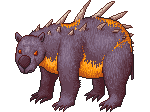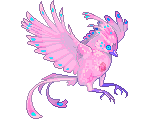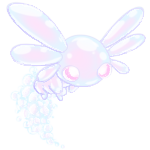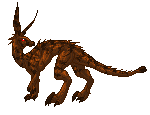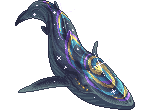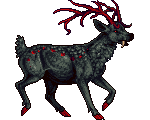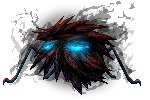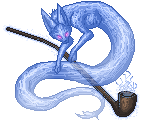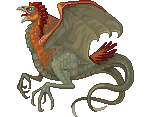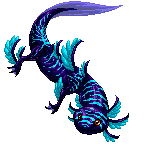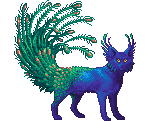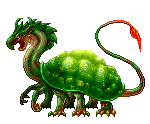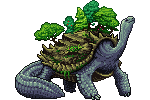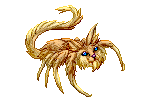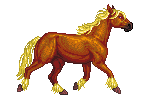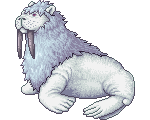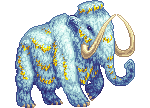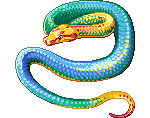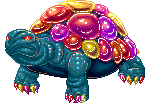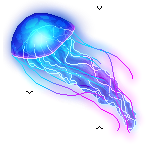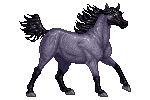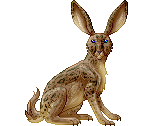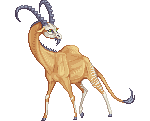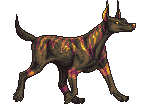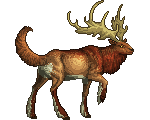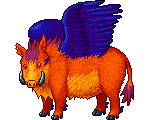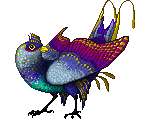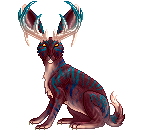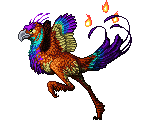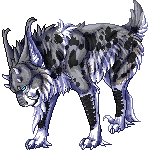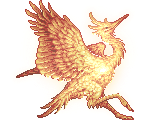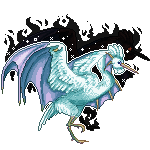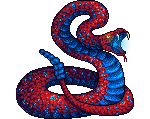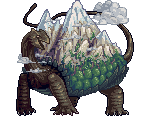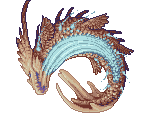Fauna Found In Multiple Realms
These creatures may be found in any and all Realms.
Arcalope

A very common type of antelope that has evolved to cope with extreme arctic conditions, native to Ristell but now widespread in every Realm with icy biomes. They have varied sizes, most comparable to a springbok at their smallest and an eland at their largest; males are often larger than the females and more heavily muscled, though the inverse of this has been noted. Both have crystalline horns, often curved or pronged, that resemble structures made of ice set above long and expressive ears. They're gifted with thick, full manes and fur that can grow over a foot long along their necks, chests, backs and tail, sometimes around their hocks and fetlocks as well. Unlike other antelopes, the arcalope has delicate clawed paws with serrated edges for easier navigation across the sheer ice of their home. Arcalopes can be found in various shades of blue, purple, pink and white, though darker coloration is very, very rare.
Arcalopes have commonly become prey for dragons and other large predators that inhabit arctic biomes. However, most adults are able to harness the element of ice to some degree to defend themselves - be it icy breath or snow manipulation, in varying degrees. Caution must be used when hunting large groups, and those young or inexperienced may lose their lives to a herd defending itself, frozen to death and unable to be recovered.
Canidae
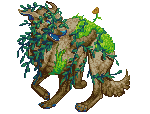
Much like felidae, canidae are elementally-gifted animals. However, that is where the similarities end - beyond one being feline and the other canine. Canidae are known to be found in the shape of a variety of different dog breeds (however they are never wolves, though wolflike breeds have been noted before), and have been sighted in all different Realms. It is said, however, that canidae evolved from dogs once kept unprotected in the magestorms of Evylon, since bred and brought through many worlds through domestication.
Canidae may best be described as false elementals. They are living, breathing, physical creatures that are so elementally attuned these elements manifest upon their pelts without harm to themselves. Canidae generally only have one elemental affinity, but two related elements have been noted - but never more than that. As a canidae ages, their element begins to surface upon their pelt, until eventually the entire dog is covered in whatever affinity they are aligned with. Due to the difficulties in elderly canidae interacting with the world, most do not live to see old age - and those that do are pets who wear specially-designed, enchanted objects to keep their magic contained.
A canidae is unable to utilize their elemental affinity consciously, and cannot control what it may harm. Fire and lightning canidae are often seen only in the wild, as they can't be kept safely as pets past puphood. Earth and dark canidae are quite popular, as they are traditionally very easy to keep. Those individuals with a single element will also be immune to their particular element, though dogs with two are still subject to being harmed by outside elemental attacks.
Cockatrice
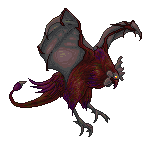
The cockatrice is a small forest & jungle breed; they're very venomous, and are hunted for their venom to make strong poisons. Related to the sarka, thought to have originally been the offspring of a smaller feylizard-like sarka variant, who began interbreeding with various types of bird. The lizard-sarka have since died off, leaving their hybridized offspring to create their own species that many have begun to call the 'cockatrice'. A cockatrice may have a barbed tail, feathered or bat wings (hybrid wings being a very rare variant). They have birdlike heads with a jagged beak, shape and size depending on what type of sub-breed of bird they're based off of. Most have scales along the body, tail; the head and feet are dark in color, with white being a rare variation. Feathers are almost always a shade darker than the scales. Their beady eyes are orange, sometimes red and yellow, and their talons are large and very sharp.
Much like gryphons, farther down the generation-line markings can get very strange coloration-wise, and hues can be very bright. Generally, they're much smarter the farther away from the original sarka and bird parents that they are. All cockatrice can't use telepathy or talk at all, but communicate in squawks and whistles that may hurt to those not expecting it. Any powers are like a sarka's, except somewhat weaker; deafness can result from a loud shriek, or momentary paralysis, but nothing more unless stricken by five or more all at once.
Dracodarnis

The dracodarnis is a large, territorial insect originating in Evylon, bred by elves to protect their gardens against pests. Since their initial creation, dracodarni have spread across the Realms both of their own accord by way of portals and by way of intentional transportation. Both males and females possess two pairs of their signature stained-glass, bat-shaped wings, which serve them a dual purpose. These bright colors are admired by other individuals in mating displays, but dracodarni are also known to use their colorful wings to focus sunlight toward plants that would otherwise receive too much shade. Certain elements to the colors and patterns of their wings are passed on through generations, allowing breeders to determine if two individuals descend from the same line. In comparison, the spines that decorate the tail of a dracodarnis are as unique as fingerprints, and have little to do with ancestry.
Though they are rarely aggressive toward species they do not consider prey, when threatened a dracodarnis may resort to using its fang-like mandibles or the spines that adorn the end of its tail to drive away a perceived threat. Minuscule claw-like protrusions line each of their legs, giving them the ability to hold onto prey whether landed or in flight. Depending on where they were hatched, individuals may employ various hunting methods. Some may use the sun-catcher like properties of their wings to draw in unwary pests while others prefer aerial pursuit. To those that breed them, they are affectionately known as 'glasswings' or 'garden guardians'.
Divine Gift Notice!When the Divine Gift item is used, this fauna species will become a member of the zirus species! However, they will have the history and appearance of their fauna species. |
|---|
Energy Snake

An energy snake is rumored to be related to the snakekind, though the truth of such claims have never been proven. They range in color from natural tones to bright colors and patterns, and are marked by the ridge of horns along their eyes and two horns on the tip of their tails.
Their bite almost always contains venom. Small doses drain energy in limited, non-lethal amounts through the victim's contact with the ground of the same Realm a snake is in (if said victim leaves the Realm, the connection is broken and the effects of the venom fade). If there's an abnormally large amount of energy present, it drains faster, also resulting in a very happy snake. The only danger of this is a fever that rarely can reach deadly levels. However, a large dose can drain energy very quickly; fever is instant, and can kill within hours. The only known cure is killing the snake.
Faegryph

Faegryphs are thought to be distantly related to feylizards; they are tiny gryphons that come in an assortment of colors and shapes, but often grow no larger than a small cat. Small-avian shapes - such as songbirds and hummingbirds - are common, as well as small-animal other halves (commonly lizards, squirrels, mice, and other such things). While they have no magic, faegryphs are nonetheless gifted with great speed and stealth, able to become all but invisible in most areas. They are commonly used as messengers and scouts in places feylizards cannot go.
Divine Gift Notice!When the Divine Gift item is used, this fauna species will become a member of the gryphon species! However, they will have the history and appearance of their fauna species. |
|---|
Famine

A Famine is essentially an undead Vystrian wolf, those corrupted by distress at being unable to find their pack in the Spirit Realm. The Famine retain a vague semblance of what they had been like in life with similar features and faded markings. As they undergo this change, however, their appearance also alters: ears take on an elongated, tattered look and their eyes shift position and split, with two more appearing at their ear tips. These extras allow the Famine to see behind them but the vision is limited to an x-ray like appearance, while their main eye - the one which appears where the original eye had been - detects infrared radiation. The final eye, located under and to the fore of the main, gives them exceptional night vision. Over time their eyes take on a faint glow which intensifies the longer they exist in this form, perhaps the only method to determine their age, which slowly turn white the older they become. Many also grow patches of longer, coarse hair, usually along the spine, tail and ankles, though the precise area and expanse varies between individuals. Any wounds they possessed before they became a Famine remain as do those they receive after the change, some healing to a point where they seem scar-like while others maintain the appearance of an open laceration.
The Famine are able to be killed only by removing their head or in the same manner of their death if it was not natural. They are unable to consume normal food, as anything which was once living turns to ash in their mouth; instead, they subsist on the energy of dead souls. Exclusively solitary creatures, they fear their old life and any reminders of it, eventually developing an intense hatred for anything related to their past and blaming their previous pack for the life they have been forced into as their memory fades and becomes corrupted. For this reason, those whose familiar follows them from the Soulplane often end up killing their companion. While Famine do not truly feel pain, their mind creates a similar sensation to make up for the lack, though it is often far less intense than true pain. They are not capable of reproducing.
In cases where a wolf dies after its familiar and later becomes a Famine, their familiar will usually be reunited with it through the Soulplane once more, though it loses almost all sense of self and acts more like a servant than a companion. These undead companions have a skeletal appearance and glowing eyes similar to their Famine counterpart.
Divine Gift Notice!When the Divine Gift item is used, this fauna species will become a member of the Vystrian wolf species! However, they will have the history and appearance of their fauna species. |
|---|
Felidae
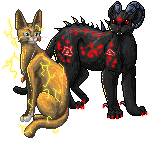
There exists a diverse, feline species across all the Realms called the felidaen; often referred to as felidae for a single individual; felidaen for plural, though 'feli' has also been recorded. They originate from Xaeri, and now can be found anywhere across all worlds. Most can have wings, horns, two tails, extra toes, and other such mutations, as long as they follow the guidelines of their elemental affinity. Each felidae is aligned with a specific element, and rarely breed outside of their own kind. Hybrids between felidaen are occasionally allowed, but usually end up either one or the other. Hybrids between species, however, is always permitted and usually ends up being a mix between the two. Housecat and felidae hybrids are not uncommon, and the offspring will inherit much of its parent's power. Most felidaen generally cannot speak beyond normal cat-sounds, though some are capable of telepathy, and others can write through various means (such as dipping their tail in ink).
All felidaen types have both a Xaeri name, and a common name, save for the hellcat; they can be called both. Most felidae types usually wear a pendant showing what type of felidae they are; that, or some sort of paint. One or the other is usually chosen, if not, most felidaen look like normal house cats, save for a few mutations/other features. the pendant or talisman is engraved with a rune, any shape, size, color, or anything of the sort; but only one rune per class. Hellcats do not have these.
They can be any sort of cat you desire, provided it's small-ish (Caracal, Bobcat, Serval, Lynx, Fisher Cat, Housecat, etc), and they take on traits of their element (like a thundercat would constantly be surrounded by a static field). They can only have an affinity for one element, and it usually manifests itself on he cat's first birthday. Most felidaen rely heavily on their magic, and so their physical strength is greatly diminished, and they can "run out" of magic if they exhaust their powers. They must then rest for a period of twenty-four hours.
KRAELI: thundercat; lightning element
- -constantly surrounded by a static field.
- -can control lightning, meows/roars/purrs/cat sounds hold an element of thunder in them.
- -wears a pendant engraved with the rune of K.
ZEREF: firecat; fire element
- -very hot to the touch, sometimes have sparks fly off of their pelt; pelt sometimes begins to burn with little to no damage, and can be put out at will.
- -control fire, heat, sometimes lava.
- -wears a pendant engraved with the rune Z.
JAILEN: windcat; air element
- -leaner, usually more graceful than their brethren. always has air circulating around them, even if very faint.
- -can control wind, air, even create dust devils and miniature tornados.
- -wears a pendant engraved with the rune J.
KENZOU: watercat; water element
- -have webbed paws, sometimes gills hidden in the fur. rarely, ears may take on a more ribbed and webbed appearance.
- -can swim very well, dive, and hunt for fish; can control water, summon rain, and lift moisture from the ground.
- -wears a pendant engraved with the runes K and U.
ISELI: earthcat; earth element
- -very heavily built, with large claws and broad paws. usually have a fine coating of dust along their backs, and sometimes have small flowers or thin vines that grow out of their fur.
- -can move rocks and boulders, raise stones from the ground, grow plants, heal flowers, etc etc.
- -wear a pendant engraved with the rune I.
LITHAE: icecat; ice element
- -frost gathers on their pelt. some may have icicles hanging from the muzzle, belly, or tail.
- -can control ice, frost, cold air, and freezing rain.
- -wears a pendant engraved with the rune L.
FAELIS: lightcat; light element
- -often glows, and usually have light pelt colors. eyes are almost always luminescent.
- -control light energy, light, can also bend rays around them to appear invisible or just a shadow.
- -wears a pendant engraved with the rune F.
DN'EIREN: shadowcat; dark element
- -usually dark-pelted; shadows cling to them like spiderwebs. -can control shadow, darkness energy, and become invisible at night and in dark places.
SAI'JAN: glowcat; non-elemental
- -have several tendrils, similar to catfish whiskers, and the longest of which have bio-luminescent glowy bits at the end. ears have a a similar tendril coming from the tip, like a tuft of fur.
- -body is also covered in bio-luminescent spots along the chest, along the ribs and side of the animal, and the face. tail forks at the end, and between them is a similar bio-luminescent glowy bit.
- -color of the glow can vary, depending on the individual, and they don't specialize is elemental magics, but rather on reiatsu and energy devouring.
- -wears no pendant.
TAE: bladecat; non-elemental
- -non-elemental class of felidaen with blades hidden within their pelt, much like the rathar. bigger than most other feli, often found with blade-like ram's horns and sharply-bladed claws.
- -wears a pendant of a broken metal blade.
HELLCAT: demoncat; general info
- -have the proportions of a larger cat species (tiger, cougar, leopard, etc), but unrestricted in color and markings. around the same size as other felidaen, perhaps slightly larger. follow the demon Kingdoms, described below.
- -runes that glow with the hellcat's personal reiatsu line their sides in patterns unique to each feli, sometimes also found on their heads, legs and tails as well. smaller runes surround those that mark each of the demon hellcat kingdoms. each hellcat MUST have these runes.
- -when born, appear to be normal housecats; gain hellcat features as they age.
- -many have a normal-cat guise.
HELLCAT: demoncat; WAR Kingdom
- -sometimes have ram's horns.
- -quite large, ports barbed claws like raptor-hooks at the back of each paw. thornlike protrusions line their spine and tail.
- -runes shown are a combination of W and R.
HELLCAT: demoncat; PESTILENCE Kingdom
- -almost always have amber eyes.
- -pelt often seems wispy; poisonous to the touch. longer claws with venom pockets as well.
- -runes shown are a combination of P and E.
HELLCAT: demoncat; FAMINE Kingdom
- -very likely to have wings.
- -lean, built delicately, very fast. have saber-fangs, and longer tails.
- -runes shown are a combination of F and E.
HELLCAT: demoncat; DEATH Kingdom
- -most have horns behind their ears
- -beneath their fur, scales cover the shoulders, back, neck and dot around the eyes.
- -runes shown are a combination of D and H.
Divine Gift Notice!When the Divine Gift item is used, this fauna species will become an athyra of the deathcat species! However, they will have the history and appearance of their fauna species. |
|---|
Feylizard

Feylizards are common, tiny dragons that generally grow no larger than the size of a small dog; all have colors that are aligned with their abilities, unlike their much-larger cousins. Most only have marking colors relating to their element; other marking colors unrelated or not enhancing to their primary power are very rare (such as a Red fire-based feylizard having grey, ice markings). The most common base and marking colors are directly related to their primary, such as a White having green markings, resulting in a light-aligned feylizard with an added healing ability.
Common colors can have any accent marking, be it common, uncommon, or rare; however, a rare base and a rare marking color is unheard of. Other than colors, however, the designs and style of feylizard are as free as their larger counterparts. They can look like any type of legged dragon, though more serpentine species are rarer; western and wyverns are most common. They can be scaled or furred, feathered or webbed, have frills or horns or any sort of decoration possible.
COLOR TYPES: COMMON:
- grey tones = ice
- blue = water
- light blue = air
- red = fire
- orange = lava/magma
- gold = lightning
- light green = earth
COLOR TYPES: UNCOMMON:
- white = light
- black = dark
- green = healing
- dark green = poison
- yellow = sound
COLOR TYPES: RARE:
- dark blue = emotional influence
- crystalline = camouflage
- silver = metal manipulation
- purple = reiatsu
- violet = luck/probability
- color-changing = teleportation
Divine Gift Notice!When the Divine Gift item is used, this fauna species will become a member of the dragon species! However, they will have the history and appearance of their fauna species. |
|---|
Forestwolf
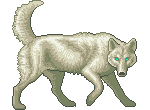
Forestwolves were originally seen as dumb, malformed eucyons in the First Realm; they were brought over like many sentient species, and continued to breed and multiply despite their lacking of sapient intelligence. When Time took the eucyons and transformed them into wolves, these creatures were no different - they were changed as well, and set back upon the Realms to live their lives as they willed.
However, forestwolves as they came to be called never regained their lost intelligence, nor harnessed any sort of magic or ability of any kind. They may be found in both natural and unnatural colors, but lack the mutations and growths of Vystrian wolves, and are considered animals by even their more advanced wolven brethren. Many forestwolves are hunted by larger predators, but are best known for harassing the lone traveler on the roads between cities.
Divine Gift Notice!When the Divine Gift item is used, this fauna species will become a member of the wolf species! However, they will have the history and appearance of their fauna species. |
|---|
Gambey Horse
While similar in function to the Middling, this shorter equine is often used for children's mounts and smaller humanoids. Though bred to be docile for use by the common people, this pony still retains a bit of spirit and playfulness. Excellent jumpers and fast despite their small size, the often make good courier mounts.
Colors noted: Black, Bay, Brown, Chestnut, Grey, Roan, Dilutes common. Pintos rare. Appaloosas are not seen.
Based upon: Welsh Section B, Connemara, New Forest Pony.
Divine Gift Notice!When the Divine Gift item is used, this fauna species will become an equus of the unicorn species! However, they will have the history and appearance of their fauna species. |
|---|
Gorecrow
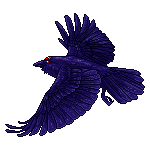
A gorecrow is generally depicted as a three-eyed crow will dull black feathers and scarlet irises; middle eye is usually darker and/or a different color than the normal ones, is slightly bigger, and located on the forehead. Most gorecrows are primarily denizens of Hell, though can be found wherever the dead may roam. They may be able to sense ghosts, and will follow undead, considered viable companions to any necromancer. Though they are undead themselves, they may be found picking at carrion or diving at members of the freshly dead for food.
They are created via necromancy gone wrong; instead of the soul drawn back into its former body, the soul is misplaced in the body of a normal crow (often found near the dead anyways, being scavengers). The crow either transforms into a gorecrow, developing the third, demonic eye - or the susceptible bird dies, releasing the spirit back into the Soulplane and away from the necromancer who failed. The newly-trapped soul loses its humanity and sense of self becoming a nearly-mindless creature, driven only by instinct and the dark magic that lay within. Gorecrows can be seen expressing longing or mourning if present watching a necromancer work - often thought that the soul within is longing to be set free. All gorecrows are immortal, slain only with strong magic of light, charred to ashes by fire, or a clean beheading.
Lunar Butterfly

Also called 'wisps' in many human cultures, the lunar butterfly is a mythical, yet very real, creature wreathed in mystery. They are generally large (3-inch wingspan) butterflies with decorative wings that glow with white light. White extends along the leading edge of each wing, and expands in decorative patterns unique to each insect. The color and shape of the wing varies with each as well as the designs of other patterns on the non-white parts of the wing.
During the day, their glow disappears into flat white, and grows at night, only when the moon rises. The brightness of glow wanes and waxes with the moon (ex. on a new moon, only the heart of the whitest markings would glow; on a full moon, the white would glow as brightly as the moon itself). When flying, this glow makes them seem like small flickering lights, and are frequently spotted by travelers moving by night. Sometimes, they are mistaken for a lamp or lantern, and unwary travelers may follow them off of beaten paths to unknown fates in the middle of the wilderness. Sometimes, lunar butterflies are regarded as good omens when spotted up close; but a bad omen when spotted from a distance. Elves revere these creatures as creations of the gods, and honor them whenever they're found in the woods.
Rarely, a lunar butterfly will choose to help one in need, usually someone lost as mentioned above. They're most partial to children and Lunar dragons, they may connect telepathically with them on nights of the full moon only.
Divine Gift Notice!When the Divine Gift item is used, this fauna species will become a member of the zirus species! However, they will have the history and appearance of their fauna species. |
|---|
Middling Horse
The breed most commonly owned by the average humanoid, the middling is a docile mount. The average intelligence is low, but they are diligent workers and are very easy to train for a variety of tasks including riding, packing, and pulling carriages. While height varies, they typically have a stocky build and remain very sound throughout their lives.
Colors Noted: All, pinto and appaloosa rare.
Based upon: Stock breeds.
Divine Gift Notice!When the Divine Gift item is used, this fauna species will become an equus of the unicorn species! However, they will have the history and appearance of their fauna species. |
|---|
Mlithirr
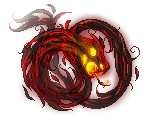
A small, but powerful, type of non-sapient pseudo-elemental that takes the shape of a snake. These serpents manifest as magical or elemental energy, born of energy storms, magestorms, godstorms, or reiatsu storms, more rarely found as a byproduct of great magic use infused with strong emotion. These snakes commonly don't have corporeal forms, but bodies made of whatever magical substance gives them life. Most are several feet long at most, though few will reach upwards of twenty, and others may not be more than a handful of inches from snout to ethereal tail. Most elements show up as specific classes of serpent, though the types and structures vary from individual to individual.
Mlithirr, commonly known as 'skeels', can be found in any Realm and under multiple conditions. Thought to be shredded souls trapped and given form by an abundance of energy, mlithirr show a small semblance of intelligence, though never true sapience. They last for days to weeks after manifestation before dissipating when their magic runs dry, unless sustained by alternate means. They are creatures that are in constant levitation, unable to settle on solid surfaces without damaging them regardless of their size or magical alignment. They have visible eyes and mouths that glow with bright color, believed to echo the aura of the spirit their form manifested from. Most often, they are considered very dangerous, and may attack with their magic with little to no provocation. However, rarely these skeels may be docile, and able to be tamed by patient and wary mages.
The chart beneath holds their varied appearances, as well as how common they are when birthed in a magical storm or magic overuse/emotional use.
Fire: common
- viper typing, most commonly resembling rattlesnakes in the vague triangle shape of their heads. bodies consist entirely of flames, embers and/or smoke.
Water: uncommon
- viper typing, most commonly resembling water moccasins in the vague, but sharp triangular shape of their heads. bodies consist entirely of water, mist and/or swirling rain.
Air: common
- colubrid typing, most commonly resembling vine or whip snakes in the slender, sharp shapes of their heads and form. bodies consist of wind and air, as well as visible distortion where they pass.
Earth: uncommon
- python class, and the largest of the mlithirr. bodies may consist of leaves, vines, wood, rock or sand. great variation in size and color.
Lightning: common
- elapid class, most commonly resembling hooded cobras, though an uncommon few will lack the vague hood-shape. bodies consist of various colors of lightning.
Ice: uncommon
- colubrid class, most commonly resembling the hognose in the upward curve of their vague snouts. bodies consist of ice, snow, and/or swirling sleet.
Light: common
- colubrid class, of most common smooth-bodied types. incredibly varied in color. bodies consist of all shades of light, with a constant bright glow that may be difficult to look at directly.
Dark: common
- boa class, of most common types. bodies consist of shadow, darkness, and can be any dark color, though the most common are blacks, reds, blues and purples. difficult to see except in strong light or midday.
Energy/Aura: common
- most varied of the mlithirr and can be of any snake class. bodies consist of pure energy or reiatsu in any form and color. most dangerous of all.
Divine Gift Notice!When the Divine Gift item is used, this fauna species will become a member of the elemental species! However, they will have the history and appearance of their fauna species. |
|---|
Ophidian

Ophidians are found commonly in the deep oceans, generally keeping away from the shore. They are massive creatures best described as a sort of snake or eel. Serpentine in appearance, they sport a large, often spined dorsal fin from head to tail, with two smaller fins just behind their gills. They have a wicked set of curved, ripping fangs, and are not afraid to put them to use. Their coloration is almost invariably blues, greens, and teals.
Of similar size and shape, ophidians share a unique relationship with leviathans; they are both a predator of, and prey animal to, this intelligent race, and constantly compete with them for survival. Ophidians are dangerous prey to hunt, and a larger specimen may kill an average leviathan with ease. Thus, when hunting ophidians, leviathans must be careful to avoid larger serpents, and only go after those they may physically overpower.
Sandworm
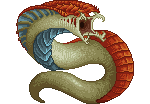
Sandworms are large, predatory worms that dwell beneath the sand; they have sizable plates covering the tops of their fleshy bodies, and scutes protecting their bellies. Some may sport large, snakelike hoods, and may have brighter coloration than their fellows. All non-plated flesh is the same color as the sand, and is relatively easy to harm.
While sandworms are predatory, they serve as mutual predators to the leviathans beneath the sands; they hunt smaller leviathans, and larger leviathans may hunt them in turn. Most are capable of harming any creature, and they are exceedingly physically strong.
Santelmo Moth

An offshoot of the entrancing, benevolent lunar butterflies, santelmo moths attract young children who do not know any better. They appear as larger than normal moths with dark coloration and glowing markings unique to each individual. This glow is a remnant of their relation to lunar butterflies, but with a much darker purpose; it is this shimmering light that draws away the children that these creatures make their meals.
To most, it is unknown what exactly happens to these children. Some say that these creatures morph into their true form once they are sure they have drawn them sufficiently away from other things that would steal their prey, and consume the souls of the young. The bodies are rarely recovered, as they begin to disintegrate after being touched by the moths' foul magic. Thankfully, these abominations are endangered, as these creatures often drive away the very species they use to disguise themselves away - their very existence inspiring fear among the locals, forcing them to either hunt the moths down or starve them of their preferred prey.
Against those with stronger spirits, a santelmo moth has little defense; its true form may not attack physically, and their spiritual attacks can be deflected by one with a stronger soul. Their physical bodies are just as fragile as a true moth's.
Divine Gift Notice!When the Divine Gift item is used, this fauna species will become a member of the zirus species, a true zirus sub! However, they will have the history and appearance of their fauna species. |
|---|
Vargr
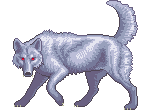
The vargr are to forestwolves as direwolves are to Vystrian wolves. They are much, much larger - growing on average about the size of a horse - with larger jaws that have long, curving saber-fangs and crushing teeth. Their coats are shaggier, and they have longer claws to better grip large prey with, and thrive in a variety of different climes.
Vargr are very social, living in packs that range from five to twenty individuals, the majority of which follow basic pack hierarchy. Alphas are much larger and more powerful than those they lead, and pack leadership is often decided by strength alone. Lone vargr may take over forestwolf packs, though interbreeding between the two is rare and often results in sterile offspring.
Though vargr wolves may be tamed and trained, this is exceptionally difficult to do, and takes a great amount of patience and skill. Some - Icemarkians being the most common - take vargr pups to train, and often end up with capable, loyal mounts possessed of deadly cunning.
Divine Gift Notice!When the Divine Gift item is used, this fauna species will become a member of the Vystrian wolf species! However, they will have the history and appearance of their fauna species. |
|---|
Veryl Deer

The veryl deer, or swiftdeer, is a species of fauna originally native to Evylon, now found commonly wherever there are lush forests to dwell in. Colors and hues are usually muted, and while markings may be found, they rarely manifest. Females, called 'does', are often smaller in stature than their male companions and often travel in small groups. Males, called 'bucks', have large antlers that drop in the spring and regrow over the summer, used for both defense and courtship rights.
Swiftdeer are so named for their extravagant speed; they are very fast and may leap over great obstacles with ease, making them challenging for a hunting chase. They're commonly preyed upon by a variety of animals, however, and their venison is said to be very rich if somewhat sour in taste.
Divine Gift Notice!When the Divine Gift item is used, this fauna species will become a member of the Evylonian deer species! However, they will have the history and appearance of their fauna species. |
|---|
Whakeira

Also known as 'wavebreacher whales', especially outside of Noctis. A very large species of whale found primarily in Noctis, though populations have since been introduced to Felnova (several hundred years ago) and Xaeri (very recently). They may grow up to over two-hundred and fifty feet from snout to tail tip, and appear similar to the more traditional blue whales they branches off of, though their physiology is sharper, with heavy plates protecting their heads and backs, long tails, and paddle-like fins. Shimmering semi-translucent frills line their flanks, length and style differing from individual to individual, and long feather-shaped frills adorn the heads of grown females. A single large gem sprouts from their forehead between and in front of large, expressive eyes, one that enhances an otherwise-latent version of non-verbal telepathy, allowing the whakeira to impart images, feelings and memories upon one who cannot understand their song innately.
Three distinct populations can currently be found in the Realms; their native numbers in Noctis, a stable population in the oceans of Felnova, and a recent but established number in Xaeri. Both Felnovian and Noctisian whakeira have spread significantly enough to have regional variation in appearance near the equator (bolder colors, thinner plates, more extravagant decoration) and near the poles (lighter colors, thicker plates, more robust musculature) while Xaerin wavebreachers are most akin to their common types in the middle waters. Noctisian whakeira are commonly hunted by the sea peoples and their meat, hide and bones are traded throughout the kingdoms, even during times of war, though responsible hunters are careful to use widespread hunting grounds to not disrupt the species' natural population balance. In Felnova, the introduced population is carefully maintained by Yorije, though they are common prey of leviathans and dragons alike. These whales are very rarely, if ever, hunted in Xaeri. Whakeira gems, when harvested correctly, are very valuable items capable of long-distance telepathy magic - but must be quickly extracted and magically sealed, as they become immensely fragile soon after the whale's death. Thus, these rare gems have become black market items, and the attempts of the Sea Kingdoms of Noctis and the country of Yorije to control them are thwarted by crafty and careful poachers.
The majority of whakeira dwell in the upper layers of the ocean where the sunlight is rich and plankton are plentiful. They are peaceful, nomadic creatures that travel around the globe in small pods during their migrations. They feed by filter-feeding, and do not possess sharp teeth or tusks, much like blue and humpback whales. They are monogamous and usually mate for life, which contributes to their relatively low numbers, despite having a calf every two seasons. They also have somewhat slow growth, taking two years for a calf to reach adulthood, which is when they leave their pod and seek out their own partner. As water-aligned creatures, their abilities are mostly focused in water manipulation, usually defensively during extreme situations in order to flee from predators or danger. It is extremely rare for a wavebreacher whale to attack unprovoked, but not unheard of.
Divine Gift Notice!When the Divine Gift item is used, this fauna species will become a member of the atlantean species! However, they will have the history and appearance of their fauna species. |
|---|
Woolyhorn

The woolyhorn is large in stature, and dangerous in nature. A highly territorial creature, it is liable to charge with little provocation, ready to fiercely protect the area it has claimed. The sizable horn on its nose is its most notable threat, capable of goring a victim with ease, but it is not the only attribute that makes it formidable. It also sports a pair of saber fangs, sharp claws, a hefty weight, and tough skin underneath masses of shaggy fur.
Their coloration is typically some shade of brown, though colors from white through grey to black have also been noted. Many have coats may also display simple markings, such as spots or stripes.
Woolyhorns are known to be omnivorous in nature; while they dine primarily upon plantlife, they have also been noted to actively hunt, and are formidable prey for dragons and other such creatures. In some areas, hunting of woolyhorns by humanoids is considered too dangerous, and they are actively avoided.
Click on the title to see fauna that exist in multiple Realms!


